Up early morning. With the street sweepers.

Up early morning. With the street sweepers.


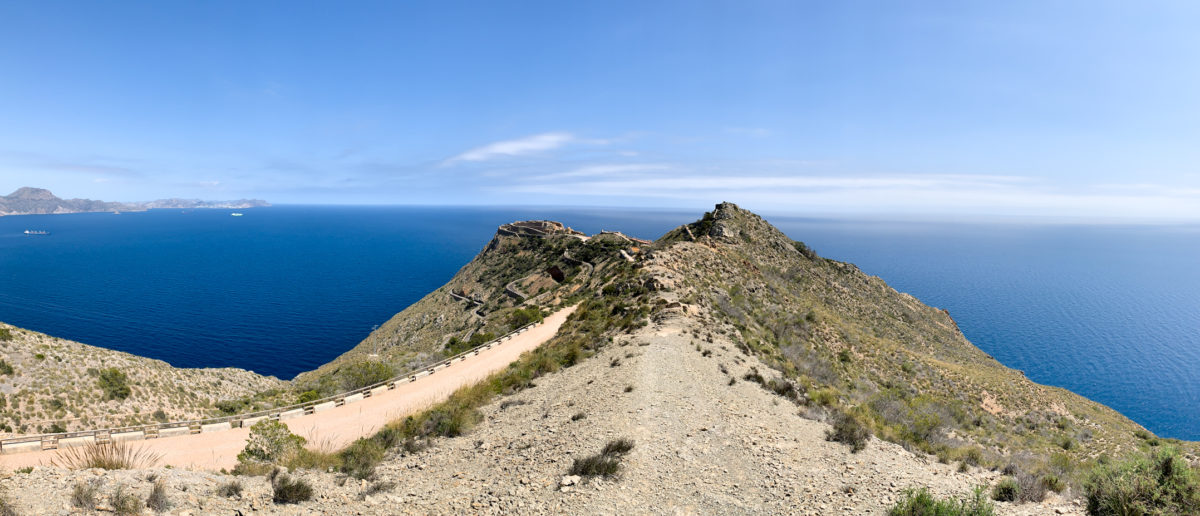
Dear Friends,
I wanted to write this for a week now. The boat keeps us busy with 10 to 12 hour work days.
This blog entry will be short -more photos than text, which in this case makes sense anyway. Photographing landscape becomes easy with deep blue skies and sunshine. In this region of Spain the sun shines for 330 days per year or so.
We went to the ‘Battery Castillitos’ west of Cartagena. See more under: http://www.castles.nl/castillitos-battery and https://es.wikipedia.org/wiki/Bater%C3%ADa_de_Castillitos
Pretty mountain roads going up and down. After every bend on the road opens another splendid view. Sometimes we just stopped, sat on a rock and soaked the view in. It was a great day!












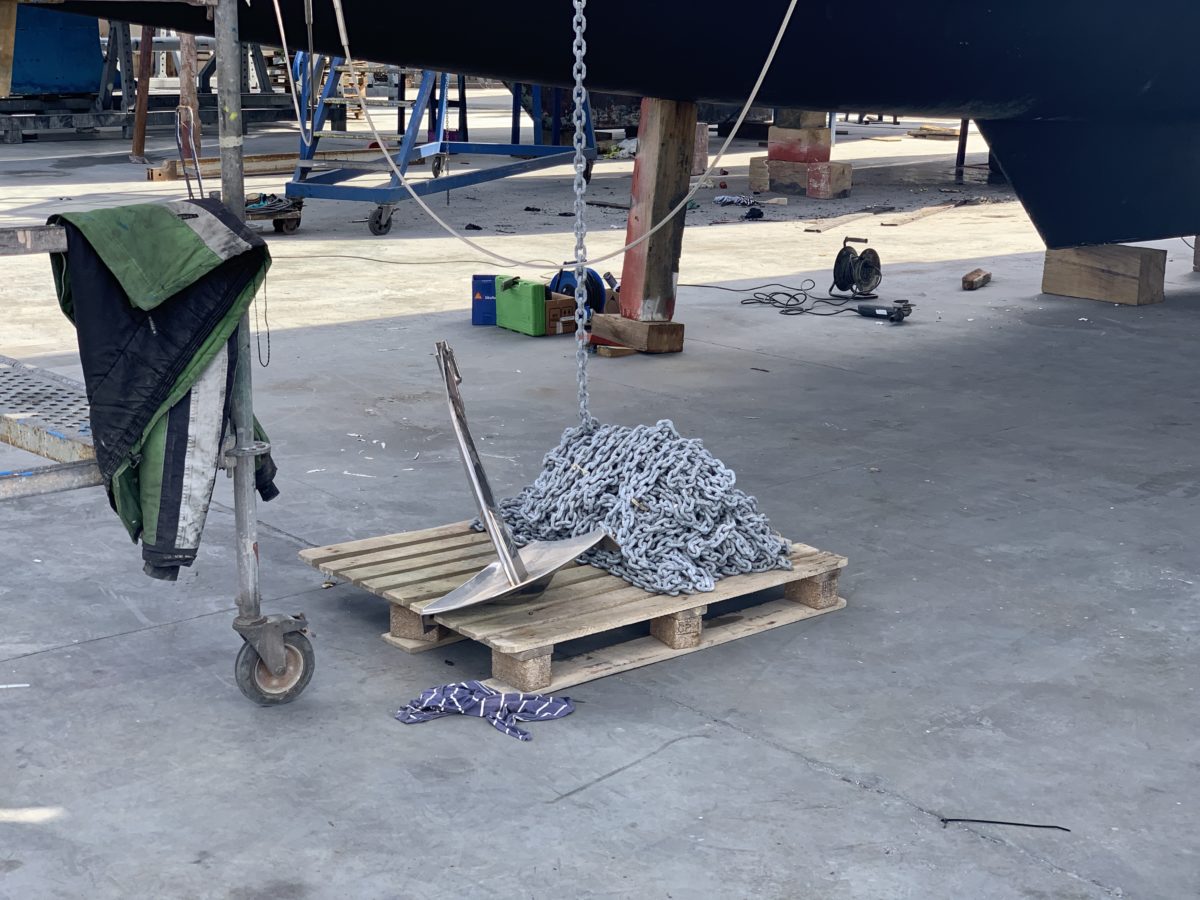
We are at ASCARS shipyard in Cartagena and despite it’s Saturday, the work continues. Quality of work so far is impressive and their willingness to understand what the customer wants is great here. Management speaks excellent english and is always outside on the yard to inspect the ongoing work on all the boats here. Large and small customers gets treated equally well.
I keep it short this morning as I have to return to the yard soon. These pictures were pre breakfast (mine). They start early here!
Below just some photos from ASCARs work




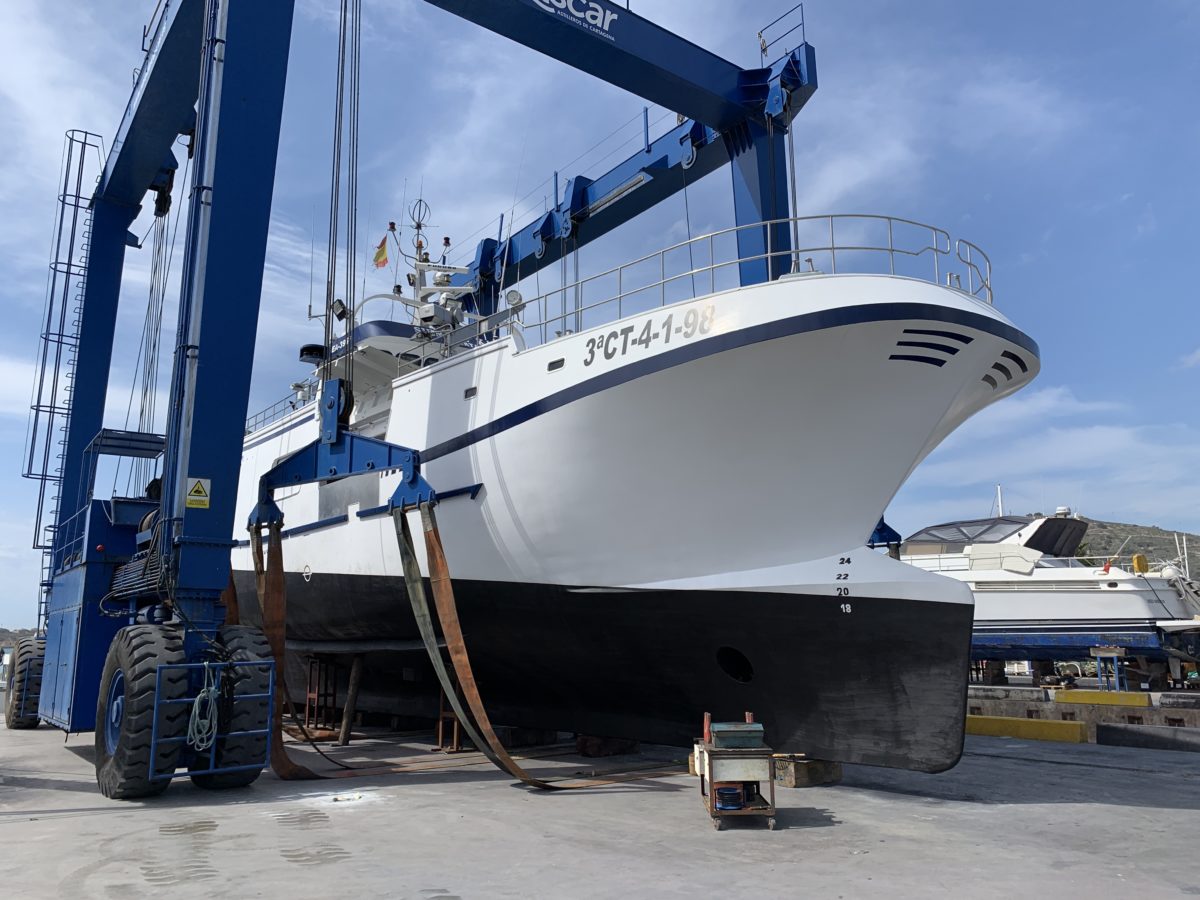
Boat yards have their Charme. Not necessarily in a warm and fuzzy feeling way, but interesting. That aside, we have some work to do. While the boat is messy anyway, we use the opportunity for repairs we didn’t dare to do in a clean marina.

The Admiral works on our ball bearing sail cars. Those are the devices which connect the main sail to the mast and allow it to slide up and down – or so goes the theory. Up yes, down not so much.
The Admiral cleans, inspects, oils and reinsert the cars onto the track. Very fiddly as the balls don’t want to follow the orders of the Admiral.

I dropped the rudders with the help of a friend. We want to inspect the shafts and ensure that we do not have any signs of damage from stray electrical currents. You might remember we had some wiring errors. We will also inspect the saildrives. All non bronze thruhulls will be exchanged in order to be safe.

We are working at the dreaded windows again. They started to leak shortly after the repair in Southern France. The 1.7m long windows became unglued in heavy weather. Catamarans flex in waves and and the windows are simply too long. We cut them in half and glued the two pieces into the cutout. The cut center rests now on a fiberglas bridge with a 10mm gap. There should be ample room for them to move when underway. The glue becoming undone should be a thing of the past – I know famous last words 🙂

Our crash boxes had water leaking in from the so called dolphin stays. We will reinforce the area with some layers of roving glas fiber mats and should be fine afterwards.

I am heading back to the boatyard, got called and have to break of here.
Bye
Scheduled Underwater Inspection
Changing 2 sea-valves and thruhulls with a ‘problematic’ installation method. We hope to splash early next week. 

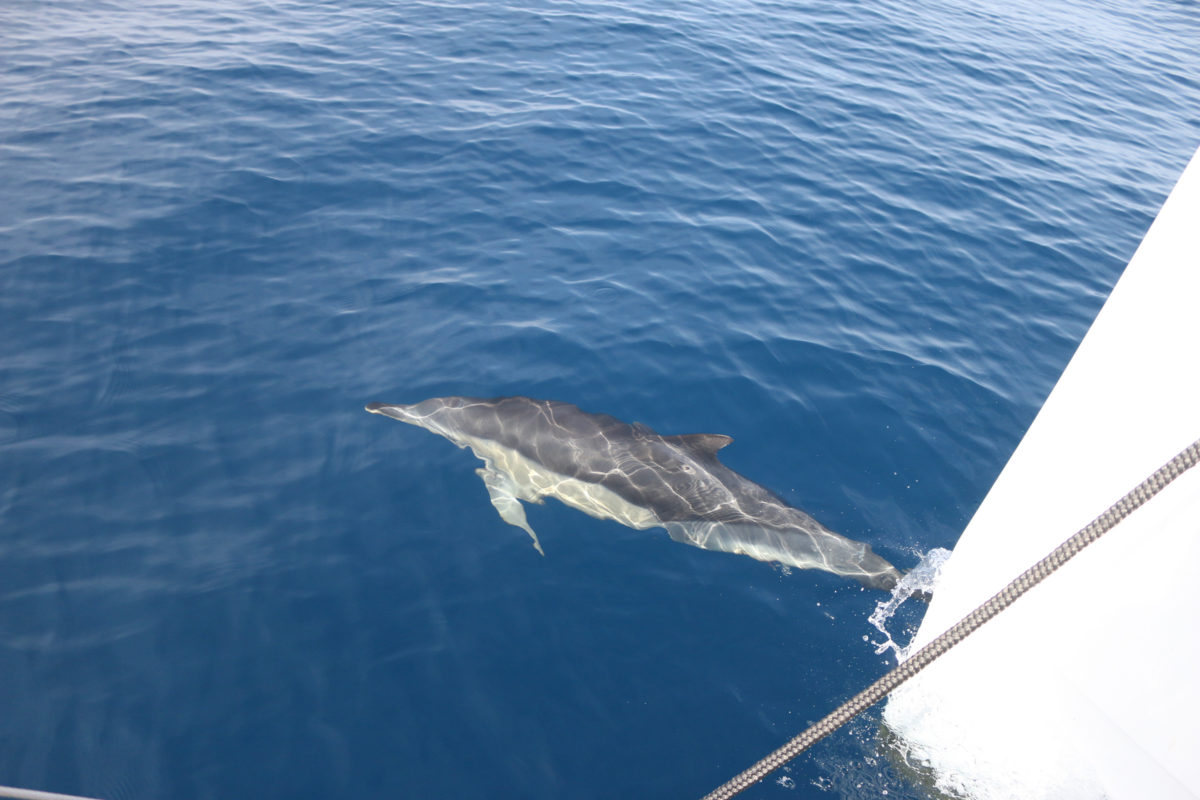
Initially we planned to sail straight to Cartagena, Spain which is a 48hours+ trip. The weather forecast made it wise to to split the journey into two legs. Wind and waves for the second night were not what we consider nice.
I am writing part of this underway update during my night watch. It’s midnight right now (local time). By the time this blog update is published we will be in Denia.
The wind is variable from 2kts to 8kts. We have the port engine running.
It’s a very quiet watch with occasional commercial traffic. I prefer night watches with some action, as it is so much easier to stay awake.
At the moment one vessel is overtaking us. “Atlantic Island”, a small cargo vessel is catching us from behind with a 3.8kts relative speed. You can see him near the 3nm ring on the radar

But back to the beginning. In the last days before our departure we finally got some of the spare parts we needed. In the end we stayed 4 weeks in Roda de Bara and were very happy about the location, not so happy about the waiting.

The marina facility is in good shape. The people in the marina and Capitaneri are very friendly. We met some cool liveaboards on our dock. And Francis from the local chandlery is a gem. We will return one day.
We explored the nearby coastal town of Sitges, which we highly recommend, see our earlier post.
We also visited a large Cava winery. Now, for those who judge Cava by what they can buy outside Spain, please reconsider. Let me encourage you to try again when you visit Spain. We saw the cellars of ‘Freixenet’. The 1910 brickstone architecture of the vinery is set in a nice landscape and felt inviting.

Cava is the Spanish equivalent to Champagne. Beyond the budget product made for export they produce excellent brut sparkling Cavas of many varieties. Freixenet’s reception has wine tasting booths with sofas in a round setting for your group or family. Together with some plates of acorn fed Iberico ham and other tasty snacks you get a great combination to try.

Back to the boat and sailing. This morning, hours before leaving, I reinstalled the autopilot controller in the engine room. The generator is decommisioned at the moment and will not be used on this trip. Beyond the issues I found earlier, which help explain the constant overheating, I researched the problem further and believe now that we whole cooling/water supply installation is insufficient to run our genset in a healthy mode.
We epoxied yesterday the mounting plate in the engine room. Today we can mount the autopilot controller box in a solid fashion.

And while being at it, I filled all the little holes in the hull, drilled for unknown reasons by unknown technicians.

Pictured above the epoxy shop on our outside dining table. The Admiral loves it when I use here kitchen gadgets like the electronic scale for work like this.
By now we are underway to Denia. After leaving the dock it typically takes an hour to clear the deck from fenders, lines and gangway, including making everything sea-safe and hoisting the sails.

Then we further waterproof the boat from above. From an aerial view our boat looks a piece of art from a trailer park. Admiral Christo @ work!

The story is that one top window started leaking again. Duct Tape is our new friend. When I retrieved a new roll from the locker I realized that this was roll #3 which means we had already duct-taped 100meters on our boat. Later analysis in port showed that the window cutout in the deck is not 100% straight and even. When the boat flexes in waves the silicone glue must compensate the different movements by stretching. With an uneven thickness, ergo being thin in some areas, the thinner part of the silicon glue overstretches and detaches from the gelcoat and ….. we are leaking from top.
Afterwards the Admiral unfolded her favorite chair on the front deck and read a book in the sunshine.
Early morning the next day, we crossed the deepest part on this trip -1276m or 4200feet.

Later in the morning a pod of dolphins visited us for 15minutes. They swam and played around under our bow. I am not sure, but it looked like they rubbed their belly and back on the soft roundings of the bow, all while we were cruising along at 6knots


The Admiral was off watch and sleeping, so I did not want to wake her up. Last time I did this, she came out and the dolphins were gone. After a while looking at this beautyful scene under our bows I caved in and woke her up. The moment she came out – quite excited and in PJs- she could see only one dolphin far back in our wake. What shall I do next time?
As we approached Denia the ship traffic increased. See the radar from 10miles out

Denia is a ferry port and home to a small fishing fleet. The ferries go mostly to Ibiza and the Balearic Islands. Some are quite fast. When you see them on radar or get the AIS warning things happen fast. You can barely see them at 2mi away, but with a closing speed of 30kts you will be in their way in 4 minutes!
The port entrance of Denia is a narrow channel which is easy to navigate in good weather. When we left on the following day it looked quite different and more challenging.

Why we split the trip into two legs you can see here. The weather we wanted to avoid begins to roll in an hour after our arrival.

The marina is nice but pricey. The views are great, especially towards the fort. With sunshine it must be beautiful here.

In the evening we took a small free ferry across the port to go to the old town for dinner.
We found a nice grill restaurant. The food was freshly grilled in the center of the restaurant, protected by glass screens and equipped with good ventilation. Food was really tasty and the local Spanish Rose was excellent.

Tomorrow we’ll get up late and prepare to leave around 1400h heading to Cartagena. More about this in the next underway update.
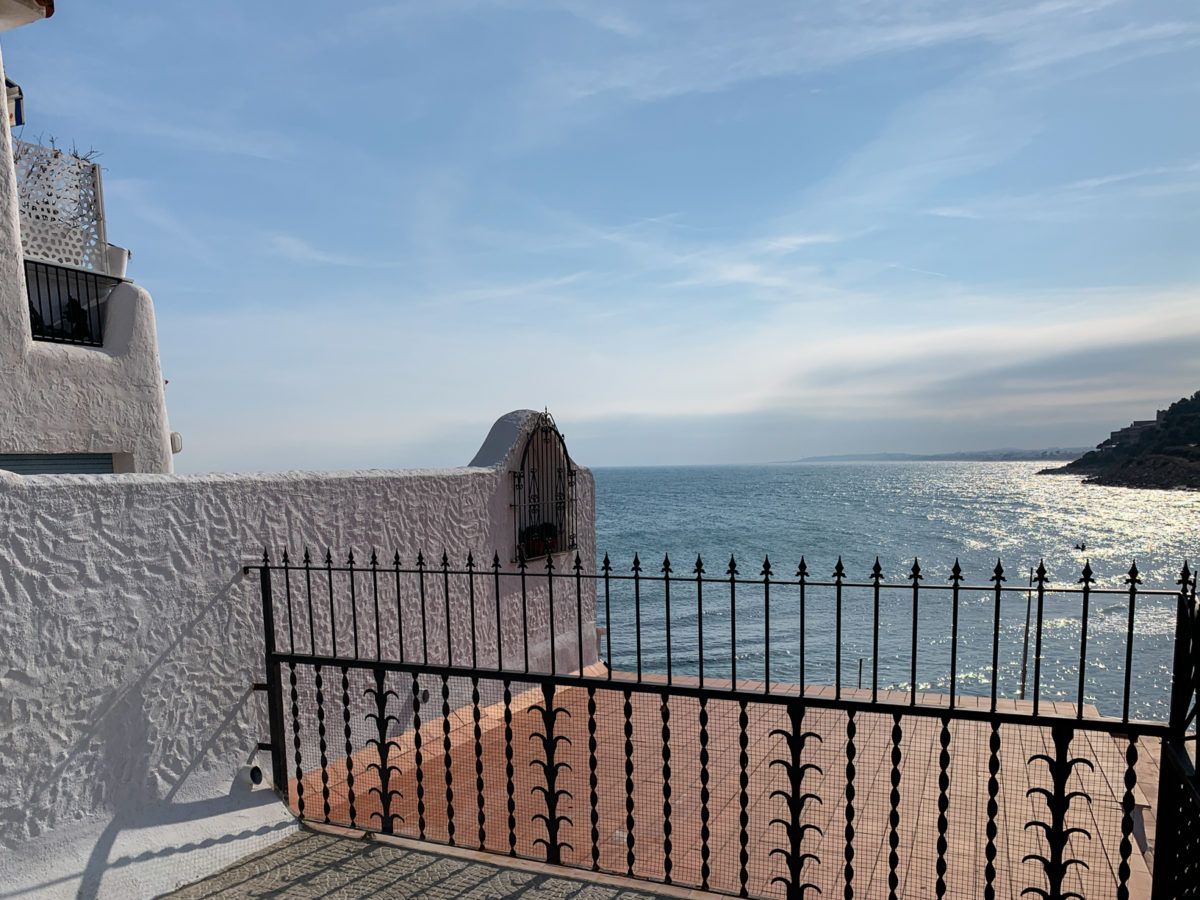
Just some pictures from our Sunday afternoon walk. Couldn’t resist to post as it is so beautiful here.
In some days we will continue our journey towards Cartagena.



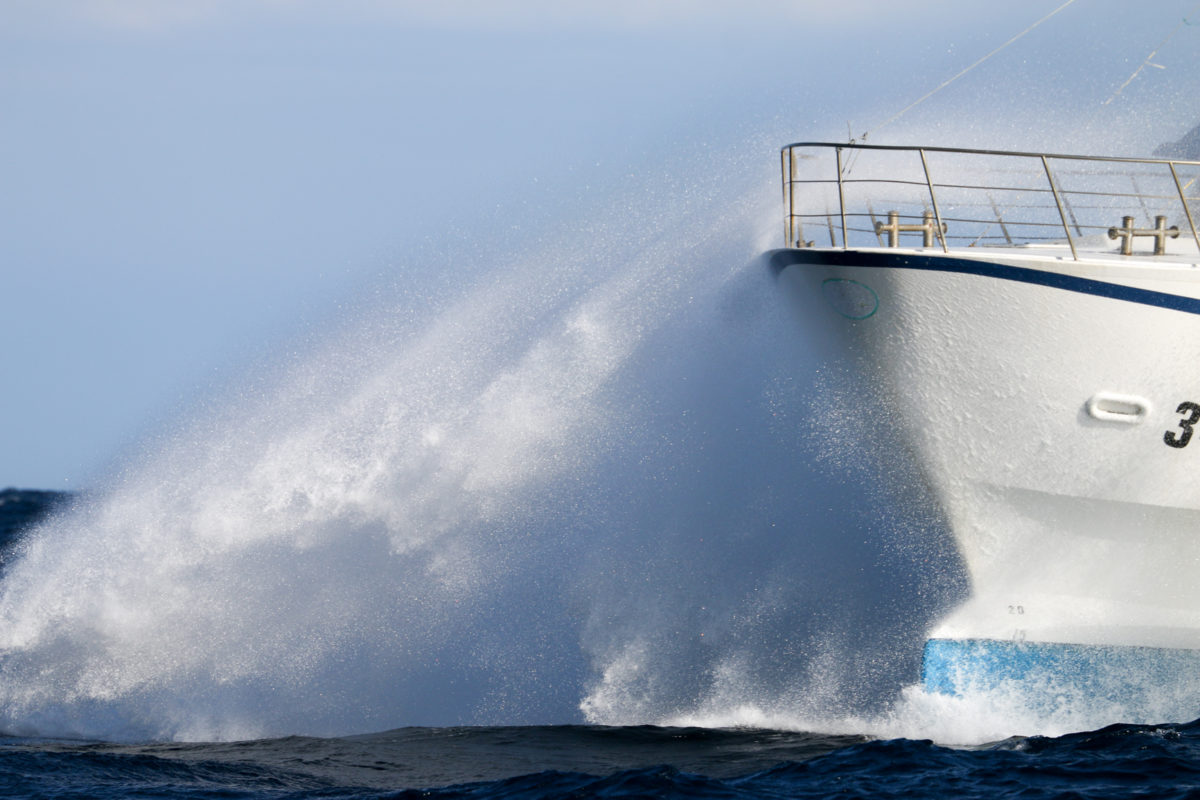
(Featured image is a fishing vessel from Port Roses. Don’t worry, the photo was shot with a Telelens)
From France to Spain March 19, 2019
Our departure day has arrived. The desire to finally sail again is getting fulfilled. In the prior week we had sailed from La Grande Motte to Cap d’Agde (35nm). We got our feet wet and tested the boat.
This trip is close to 190nm and leads around Cap Creus. The cape marks the border between Spain and France and has its reputation in winter time due to the frequent, ferocious Tramontana winds. Our plan was to pick a weather window behind a front with receding winds, but still enough wind to have the boat moving. Yeah- we got the boat moving.
Weather Forecast:

Early morning 6am UTC

36 hours later. Front has receded.
The wind forecast was nearly point on. The wave forecast not so much. For the gusts above 30kts we were prepared with a 2nd reef and had our small jib ready to hoist. In the end, the wind never felt as bad as the waves, especially 50 miles south of Cap d’Agde.
We began docking off early in the morning, but needed the dinghy to get our lines off the mooring buoys. First, we helped our friends on JAMS, a new Outremer 51, to do the same. Due to the very strong winds the night before, we had changed our mooring lines from slip through to just being tied with a bowline hitch to the mooring balls. Chafing was our main concern.
The first stretch we had planned to sail together with JAMS, who were heading to Port Vendres in France. It took more than an hour to get the mooring lines sorted out and the dinghy hoisted again. At 0930h we finally left port. The sun was shining brightly as we maneuvered out of Cap d’Agde. We noticed how slow our boat was moving due to the marine growth on the hull under water. This is caused by our long times staying in port. At 2000 rpm, on one engine, we had lost around 1 kts boat speed – down from 6.2 to 5.2kts.
In fresh wind (20kts+) we hoisted the main with a second reef and unfurled the genoa for a nice downwind heading. Soon both boats, Lunara and JAMS, sailed at double digit speeds.
The first two hours sailing were great, but the more we moved away from land the stronger the wind became and the longer fetch of free water allowed the waves to grow. The Admiral became crabby, she got the (sea) flue.

Waves in photos always look puny compared to reality. By this time we were sailing constantly 10kts+
Initially it was warmer and quite sunny. Never forget, it’s still winter.

Under way in the Golf du Lion. A bit later we encountered 35kts winds from behind and pretty good waves.

When my watch came up the temperature had dropped to 10°C. I am dressed for the occasion.
As we rounded Cap Creus, we had averaged 10.5kts and hit a top speed of 17 kts. The tripmeter’s 8.4kt average (picture below) requires an adjustment for the hour or more spent leaving the dock and raising the main sail. We were quite impressed, considering that the hull has a lot of drag from the marine growth.
10 hours into the trip, past Cap Creus, we met some fishing vessels heading home to Port Roses.

Fishing vessel south of Port Roses. This guy came very close and ignored us completely. He was crossing us head on a collision course. We took avoiding action.

This captain changed course early, to pass neatly behind our stern at a good distance.
Mid evening we passed a former dock neighbor from La Grande Motte ‘Orialine’ (Outremer 51). I just got a shot from very far away.

Night broke, the wind receded to a tad above 20 knots. Boat speed was an easily manageable 7 kts. The Admiral was still out of commission.
 No worries, as we planned to stay in deep water passing Barcelona 10 miles to the south. Started charging the batteries with the generator. After 60 minutes the generator …..
No worries, as we planned to stay in deep water passing Barcelona 10 miles to the south. Started charging the batteries with the generator. After 60 minutes the generator …..

Generator Control
…said adios amigo. Not really surprising, except it is the second, replacement generator and had less than 10 hours runtime. Upon arrival I inspected all the possible reasons for overheating and found some 🙁
The fuel pump was installed horizontal (should be vertical), which creates bubbles in the diesel and a lean fuel mix for the generator leading to overheating. Second, upon taking the water filter apart (yes, I checked the impeller pump first), I found an installation novelty: Sikaflex (silicone sealing) in the filter intake and output. Why? The filter was not meant for generators, had conical connections and the flat hose connectors do not fit a conus- obviously. So, a lot of Sikaflex was used to make it fit. Some people, please don’t call them marine professionals, should never have access in their life to either Duct-tape or Sikaflex. It should be a controlled substance and subject to something similar to a firearms permit!

Water strainer input and output looked like this!
Anyway, I ordered a proper water strainer which took 2 weeks to get here and will install it tomorrow.
Now, we run the engines to charge the batteries – yes, you guessed it right – something else happens. An Volvo engine control alarm with a piercing loud beeping signals alerts us that one of the smaller 60A alternators is charging with 15V. The electrician company later commented ‘Don’t worry, the 15V won’t reach your batteries’ Great, a) why does Volvo programmed this alarm? b) how do you sail/live with a 110dB alarm? What are my options? Not using the engine?
See ‘ALT STARBOARD R’ 15V in the picture.

Around midnight we began passing Barcelona. The town and coastline is well lit. Not much ship-traffic at this time as most ferries, cruise- and cargo ships seem to want to stay in port during night. When we had nearly passed Barcelona, at 0500h, the traffic awoke and we had to dodge a lot of the bigger guys.
The night was beautiful with clouds alternating with a full moon. Even the Admiral, in her sad state with a flu, enjoyed the view. The full moon set precisely at the time when in the east the sun was rising – magical. We sailed and motored on towards our destination Roda de Bara to arrive their early afternoon.
I was a bit exhausted, as I had been on watch most of the last 36 hours. 5 miles away from port we lowered the sails and set the autopilot on a NW course for the port entrance. We motored slowly with one engine a little above idle rpm, so that I could get an urgently needed nap for 45 minutes. I don’t like to drive into a foreign port super tired. Even a short nap works wonders (thanks Andrew for the tip!)
Upon arrival and after a messy fight with the dirty mooring lines I got our little electric scooter out on the dock and checked in at the Capitanerie. The gentlemen managing the marina is a very nice former east German navy officer. He remembered all the west German navy’s surveillance ships by name – the ones I had sailed on in the 70s. You can imagine we had a nice long check-in chat 🙂
Late next morning, after a good sleep, I inspected the boat and found some more installation defects and deficiencies. The port side main bilge pump was damaged. Someone had stepped on it most likely during the water maker repair. Two notches of the casing were broken off. The pump was sitting loose and the impeller chafed in the housing. Ordered a replacement (160 Euro!) and installed it.

Damaged Bilge Pump
Upon repair I found the pumps electrical wires had several cuts and corrosion had set in (not visible from the outside). So I replaced a longer stretch of the cable as initially planned 🙂 the joys of boat owner ship!

Port bilge pump wiring damaged. No longer waterproof.
Then working on the generator overheating issue I discovered another installation no-no. The base plate of the throughull for the generator is mounted partially free floating and not fully painted, hence, not waterproof. Ultimately, the wood will rot and cannot support the pressure from the tightened throughull. Even today, it is a compromised installation. Will haul out in Cartagena (next port) and replace!
Further, one disconnected electrical wire from one alternator (not the overcharging alternator) was hanging loosely in the bilge touching the water 🙁 Have to check if it’s still hot, as this wire was prior used to signal the house battery voltage to the alternator.
In the port engine room the B&G autopilot controller fell of the hull. It was improperly glued/Sikaflexed to the hull (see prior post). You can have some fun with this stuff – see picture below.

The SIKA man
is remarkably warmer than Southern France at this time of the year. Less wind and 300 days sunshine is more than good enough for us! Roda de Bara is quiet and idyllic in a positive way, but also means less restaurants being open during winter (nearly none during the week).

El Roc de Saint Gaieta
Some impressions of this very nice beach town:

This stretch of the coastline is part of the Via Augusta, built in 10BC

El Roc de Saint Gaieta

El Roc de Saint Gaieta

El Roc de Saint Gaieta

El Roc de Saint Gaieta

Vitamins! Banana Split.

Super clean water in the marina

Roda de Bara Marina

Marker on seawall
Ah yes, the food: Carnivores do not suffer in Spain. This is the Lidl supermarket with a great selection of local Iberico ham:

This was a long post, but fun to write. If you made it until here you deserve a glass of Rose!
Cheers!
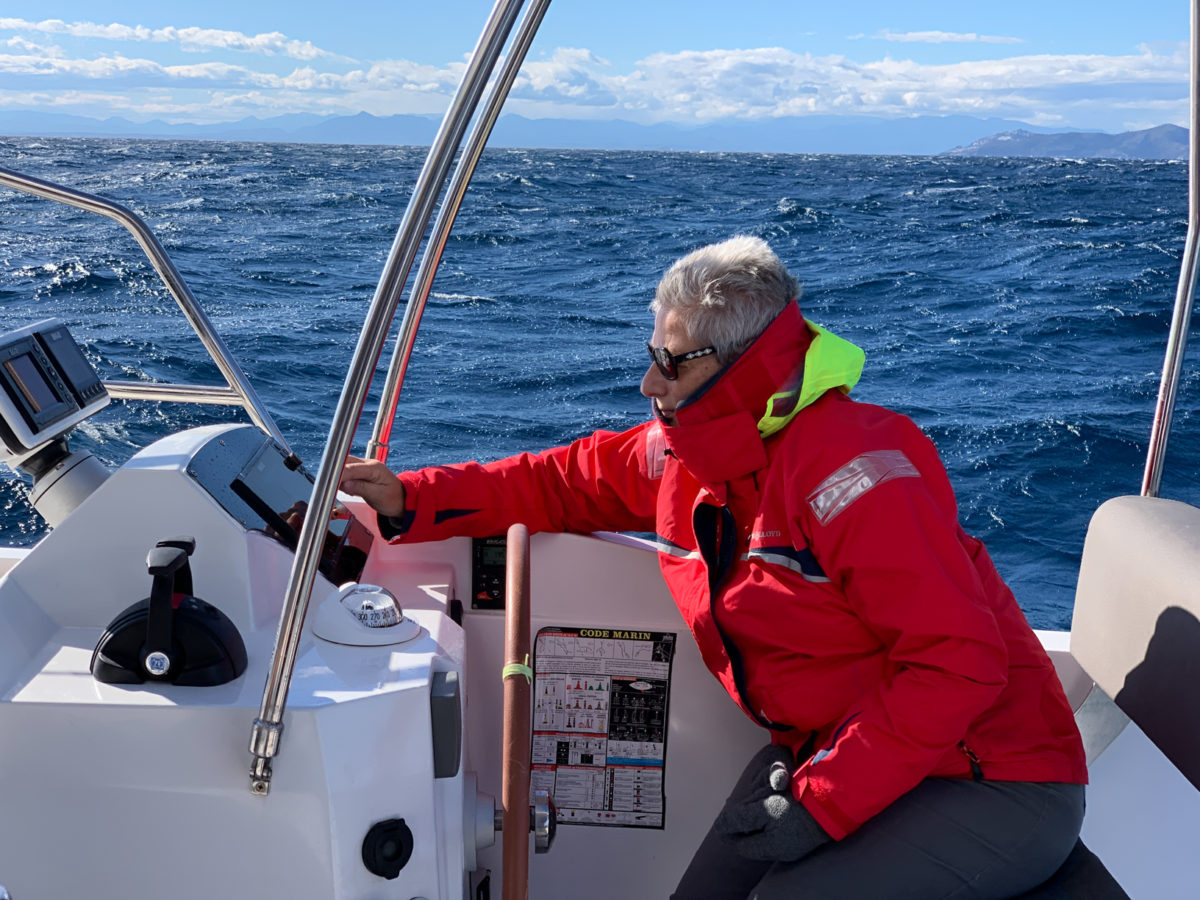
“But beware of the dark side. Anger, fear, aggression; the dark side of the Force are they. If once you start down the dark path, forever will it dominate your destiny. Consume you it will.” ―Yoda
…and
“Always pass on what you have learned.” ―Yoda
So here it is:
Last week we escaped from the clutches of evil electrons in France. On March 14, early morning, we quietly sneaked out of La Grande Motte, sailed west a baby step to Cap d’Agde – 35nm. Here we waited for a weather window for the larger leg going past Barcelona. We felt the dark force weakening.
Now, what is the Force? Since September 3, 2018, we were tied to ports in Southern France. We laid in two ports just for the convenience of the electrical systems installer to finish their work. This was their second round of correcting and finishing a failed installation which began in March 2017. Spread out over six month technicians appeared. Their working time on the boat totaled maybe 4 weeks. Five month were idle time when nothing happened – except us, in desperation, touring vineyards in the vicinity. Mondays was the technicians travel day, Tuesday the work began and Friday at noon they rushed back home, and don’t forget the two hour lunch time in France.
Practically every blue device onboard was exchanged (blue is the brand color of Victron’s electrical marine equipment). We also swapped out two destroyed alternators, one generator, one pump and many other smaller items, which were either the wrong device, not needed or malfunctioned. A shoddy installation could have been the reason for their malfunction or it could have been the devices themselves. Whatever the reason, we were tied to port.
Not forgetting the smoldering electrical fire on top of the coach roof last year and the subsequent discovery of osmosis under those six solar panels. The argument with the insurance companies about which one is responsible to pay, took a long time. It lasted into the cold, wet winter period of southern France. As a result we were limited in our ability to do lamination work. Epoxy cures above 11°C and we were most of the time below the curing temperature.
A local company – Thalassa Nautic, planed down the osmosis affected roof by some millimeters. Then we waited several weeks for dry weather with temperatures around 10°C or higher. With the help of an armada of electrical heaters and a tent over the top deck we got the deck warmed above the curing point.
Ah yes, the other thing. In Ibiza, July last year, I got an electrical shock swimming under our boat. This was a deeply disconcerting accident for me; without – thank God – physical consequences for myself. The persisting electrolysis problems and its source were finally found. An electrical bridge in the isolation transformer was missing since the very beginning of the electrical installation. This meant we built a 230V field under our boat. Sailors check “Input earth connection” as per the manual of the device!
As of today we are in Catalonia in South East Spain. Yet, the dark force is still with us, though to a lesser degree! During our first real sea-trial, sailing from Southern France to Roda de Bara in Spain, we experienced some electrical equipment failing again. The new generator stopped after 1 hour with an exhaust temp overheat message. One of the engines small 60 amp alternators generated a piercing alarm signaling over-voltage.
After arrival in port, during the post voyage boat inspection, I discovered that the autopilot control box fell off the wall in the engine room. The data cables were just holding the box, while the rudder steering cable chafed on this critically important instrument.
I was very upset about this discovery since I also found a shallow hole drilled into the outer hull, which is an absolute No-No. Even a non mariner can imagine the consequences of reckless drilling on a boat. The box was fixed with silicone to the hull side without roughing up the surfaces, another No-No. I could peel-off the remaining silicon with my fingers from the mounting board! “Do. or do not. There is no try.” — Yoda
Collateral damage from the installers we suffered a lot, like the port side bilge pump where someone stepped on and broke the pump housing letting the impeller chafe on the housing. In the starboard engine room bilge I found a small ‘Deutsch’ connector piece, which belongs to the Volvo MDI box. Another todo 🙁 . Right now, I just hope that we will not have the same problem like on the port engine, where a Volvo technician discovered an improperly installed Deutsch connector with a contaminated pin which prevented contact with the electronic MDI box of the engine. We needed Volvo to find out why we couldn’t stop the engine. The Volvo technician blamed the electrical installation company after their work on an alternator.
And now, firm promise, I save you from a continuation of this rant, except that the installation is still not complete and parts of the electrical plan need still to be installed.
 Roda de Bara is a quiet beach resort in winter and spring. Tourists begin to appear around Easter. Many restaurants are closed or only open during the weekend. We find it idyllic and like it. On the dock we met several nice neighbors including some fellow Germans and Austrians!
Roda de Bara is a quiet beach resort in winter and spring. Tourists begin to appear around Easter. Many restaurants are closed or only open during the weekend. We find it idyllic and like it. On the dock we met several nice neighbors including some fellow Germans and Austrians!

Yesterday we rented a car and toured the neighboring town Sitges, some kilometers to the east of us (direction Barcelona). Sitges is called the Cannes of Spain and we agree.

Sunshine, turquoise waves breaking on the beach, palm trees, tapas for lunch with a glass of brut Cava. This is how I imagined sailing in retirement.
Today we have to do some technical work on the boat – hint: evil ‘E’ related. We are not the first one to discover that a boat seems to be a floating construction site, which the owners surprisingly enjoy. Freud would have dedicated a whole book to sailors, why they do that and how it relates to their traumatic upbringing 🙂 .
We know why we are doing this, it’s just momentarily that the dark Force sucks the light out of the joy.
PS: we got a sample case of brut Cava onboard. In the evenings we conduct dangerous experiments with olives, cheese and Iberico ham. Any tips on how to compose the explosive mix, let us know.
Sea Urchins are protected. Only a controlled quantity is allowed to be harvested.
Today was the day for sea urchins aficionados. I tried them, not today but some years ago, and found them tasty, but the wine served with them more interesting. Here are some pictures for today’s event in La Grande Motte.